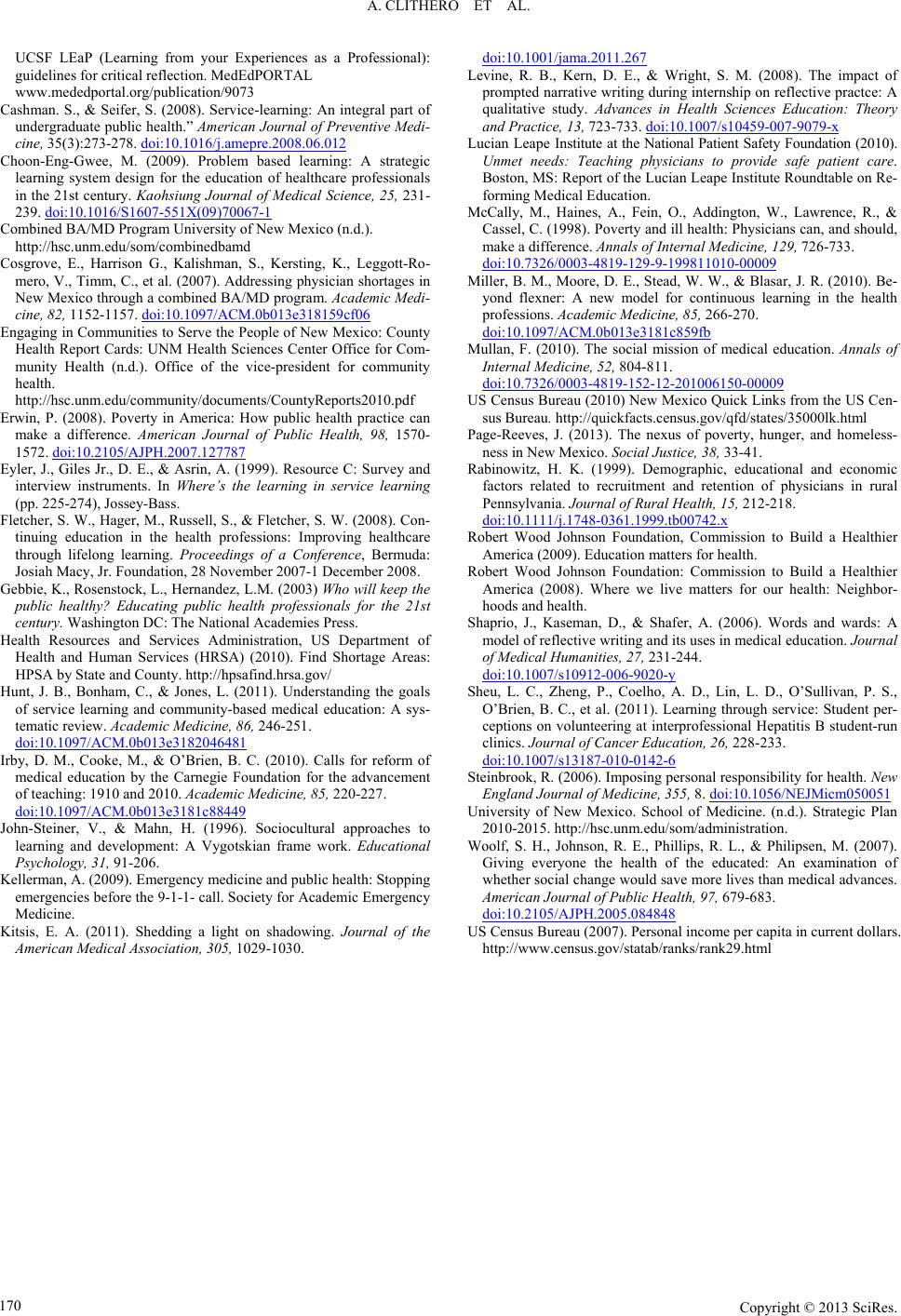
A. CLITHERO ET AL.
Copyright © 2013 SciRes.
170
UCSF LEaP (Learning from your Experiences as a Professional):
guidelines for critical reflection. MedEdPORTAL
www.mededportal.org/publication/9073
Cashman. S., & Seifer, S. (2008). Service-learning: An integral part of
undergraduate public health.” American Journal of Preventive Medi-
cine, 35(3):273-278. doi:10.1016/j.amepre.2008.06.012
Choon-Eng-Gwee, M. (2009). Problem based learning: A strategic
learning system design for the education of healthcare professionals
in the 21st century. Kaohsiung Journal of Medical Science, 25, 231-
239. doi:10.1016/S1607-551X(09)70067-1
Combined BA/MD Program University of New Mexico (n.d.).
http://hsc.unm.edu/som/combinedbamd
Cosgrove, E., Harrison G., Kalishman, S., Kersting, K., Leggott-Ro-
mero, V., Timm, C., et al. (2007). Addressing physician shortages in
New Mexico through a combined BA/MD program. Academic Medi-
cine, 82, 1152-1157. doi:10.1097/ACM.0b013e318159cf06
Engaging in Communities to Serve the People of New Mexico: County
Health Report Cards: UNM Health Sciences Center Office for Com-
munity Health (n.d.). Office of the vice-president for community
health.
http://hsc.unm.edu/community/documents/CountyReports2010.pdf
Erwin, P. (2008). Poverty in America: How public health practice can
make a difference. American Journal of Public Health, 98, 1570-
1572. doi:10.2105/AJPH.2007.127787
Eyler, J., Giles Jr., D. E., & Asrin, A. (1999). Resource C: Survey and
interview instruments. In Where’s the learning in service learning
(pp. 225-274), Jossey-Bass.
Fletcher, S. W., Hager, M., Russell, S., & Fletcher, S. W. (2008). Con-
tinuing education in the health professions: Improving healthcare
through lifelong learning. Proceedings of a Conference, Bermuda:
Josiah Macy, Jr. Foundation, 28 November 2007-1 December 2008.
Gebbie, K., Rosenstock, L., Hernandez, L.M. (2003) Who will keep the
public healthy? Educating public health professionals for the 21st
century. Washington DC: The National Academies Press.
Health Resources and Services Administration, US Department of
Health and Human Services (HRSA) (2010). Find Shortage Areas:
HPSA by State and County. http://hpsafind.hrsa.gov/
Hunt, J. B., Bonham, C., & Jones, L. (2011). Understanding the goals
of service learning and community-based medical education: A sys-
tematic review. Academic Medicine, 86, 246-251.
doi:10.1097/ACM.0b013e3182046481
Irby, D. M., Cooke, M., & O’Brien, B. C. (2010). Calls for reform of
medical education by the Carnegie Foundation for the advancement
of teaching: 1910 and 2010. Academic Me dicine, 85, 220-227.
doi:10.1097/ACM.0b013e3181c88449
John-Steiner, V., & Mahn, H. (1996). Sociocultural approaches to
learning and development: A Vygotskian frame work. Educational
Psychology, 31, 91-206.
Kellerman, A. (2009). Emergency medicine and public health: Stopping
emergencies before the 9-1-1- call. Society for Academic Emergency
Medicine.
Kitsis, E. A. (2011). Shedding a light on shadowing. Journal of the
American Medical Association, 305, 1029-1030.
doi:10.1001/jama.2011.267
Levine, R. B., Kern, D. E., & Wright, S. M. (2008). The impact of
prompted narrative writing during internship on reflective practce: A
qualitative study. Advances in Health Sciences Education: Theory
and Practice, 13, 723-733. doi:10.1007/s10459-007-9079-x
Lucian Leape Institute at the National Patient Safety Foundation (2010).
Unmet needs: Teaching physicians to provide safe patient care.
Boston, MS: Report of the Lucian Leape Institute Roundtable on Re-
forming Medical Education.
McCally, M., Haines, A., Fein, O., Addington, W., Lawrence, R., &
Cassel, C. (1998). Poverty and ill health: Physicians can, and should,
make a difference. Annals o f Internal Medicine, 129, 726-733.
doi:10.7326/0003-4819-129-9-199811010-00009
Miller, B. M., Moore, D. E., Stead, W. W., & Blasar, J. R. (2010). Be-
yond flexner: A new model for continuous learning in the health
professions. Academic Medicine, 85, 266-270.
doi:10.1097/ACM.0b013e3181c859fb
Mullan, F. (2010). The social mission of medical education. Annals of
Internal Medicine, 52, 804-811.
doi:10.7326/0003-4819-152-12-201006150-00009
US Census Bureau (2010) New Mexico Quick Links from the US Cen-
sus Bureau. http://quickfacts.census.gov/qfd/states/35000lk.html
Page-Reeves, J. (2013). The nexus of poverty, hunger, and homeless-
ness in New Mexico. Social Justice, 38, 33-41.
Rabinowitz, H. K. (1999). Demographic, educational and economic
factors related to recruitment and retention of physicians in rural
Pennsylvania. Journal of Rural Health, 15, 212-218.
doi:10.1111/j.1748-0361.1999.tb00742.x
Robert Wood Johnson Foundation, Commission to Build a Healthier
America (2009). Education matters for health.
Robert Wood Johnson Foundation: Commission to Build a Healthier
America (2008). Where we live matters for our health: Neighbor-
hoods and health.
Shaprio, J., Kaseman, D., & Shafer, A. (2006). Words and wards: A
model of reflective writing and its uses in medical education. Journal
of Medical Humanities, 27, 231-244.
doi:10.1007/s10912-006-9020-y
Sheu, L. C., Zheng, P., Coelho, A. D., Lin, L. D., O’Sullivan, P. S.,
O’Brien, B. C., et al. (2011). Learning through service: Student per-
ceptions on volunteering at interprofessional Hepatitis B student-run
clinics. Journal of Cancer Education, 26, 228-233.
doi:10.1007/s13187-010-0142-6
Steinbrook, R. (2006). Imposing personal responsibility for health. New
England Journal of Med ic in e, 355, 8. doi:10.1056/NEJMicm050051
University of New Mexico. School of Medicine. (n.d.). Strategic Plan
2010-2015. http://hsc.unm.edu/som/administration.
Woolf, S. H., Johnson, R. E., Phillips, R. L., & Philipsen, M. (2007).
Giving everyone the health of the educated: An examination of
whether social change would save more lives than medical advances.
American Journal of Public Health, 97, 679-683.
doi:10.2105/AJPH.2005.084848
US Census Bureau (2007). Personal income per capita in current dollars.
http://www.census.gov/statab/ranks/rank29.html